- Clinical Technology
- Adult Immunization
- Hepatology
- Pediatric Immunization
- Screening
- Psychiatry
- Allergy
- Women's Health
- Cardiology
- Pediatrics
- Dermatology
- Endocrinology
- Pain Management
- Gastroenterology
- Infectious Disease
- Obesity Medicine
- Rheumatology
- Nephrology
- Neurology
- Pulmonology
Making the most of pulmonary function testing in the diagnosis of asthma
Although the results of a thorough history and physicalexamination often suggest the diagnosis of asthma, confirmatorytesting is required and may be helpful in more subtlecases. Spirometry before and after bronchodilator administrationis the first step for the initial diagnosis; it also is an importantcomponent of the long-term assessment of asthma control.When the results of spirometry are normal in a patient in whomasthma is suspected, bronchoprovocation challenge testingwith methacholine is generally considered the next diagnosticstep. Numerous alternative methods of bronchoprovocationtesting have been developed, such as the challenge with adenosine5'-monophosphate. Novel methods such as the forced oscillationtechnique and the measurement of exhaled nitric oxidehold promise for more effective diagnosis and monitoringof asthma in the future. (J Respir Dis. 2008;29(4):157-169)
ABSTRACT: Although the results of a thorough history and physical examination often suggest the diagnosis of asthma, confirmatory testing is required and may be helpful in more subtle cases. Spirometry before and after bronchodilator administration is the first step for the initial diagnosis; it also is an important component of the long-term assessment of asthma control. When the results of spirometry are normal in a patient in whom asthma is suspected, bronchoprovocation challenge testing with methacholine is generally considered the next diagnostic step. Numerous alternative methods of bronchoprovocation testing have been developed, such as the challenge with adenosine 5'-monophosphate. Novel methods such as the forced oscillation technique and the measurement of exhaled nitric oxide hold promise for more effective diagnosis and monitoring of asthma in the future. (J Respir Dis. 2008;29(4):157-169)
Asthma is a chronic inflammatory airway disease characterized by waxing and waning respiratory symptoms of cough, wheezing, and shortness of breath. It is a common and increasing problem, responsible for 1.8 million emergency department visits, 497,000 hospitalizations, and 4055 deaths in the United States in 2004.1 Asthma is the underlying cause in up to 40% of young adults being evaluated for dyspnea, and it is an underrecognized cause of respiratory symptoms in older persons.2,3 Pulmonary function testing plays a major role in the initial diagnostic evaluation, assessment of severity, and monitoring of patients with asthma. The purpose of this article is to review the current pulmonary function techniques used in the diagnosis of asthma, summarize recent advances in testing, and identify novel methods that hold promise for more effective diagnosis and management of this disease in the future.
CLINICAL PRESENTATION
It is important to briefly review the epidemiology and clinical presentation of asthma because disease prevalence and pretest probability can significantly influence the predictive value of pulmonary function testing. The global prevalence of asthma ranges from 1% to 18%, with an estimated prevalence of 11% in the United States.4
Table 1 displays the common risk factors associated with asthma. A family history of asthma clearly increases the risk of symptomatic disease, although the relationship is complex with multiple genes implicated in the pathogenesis. While the prevalence of asthma is nearly twice as high in boys as in girls younger than 14 years, the overall prevalence is higher in women than in men.
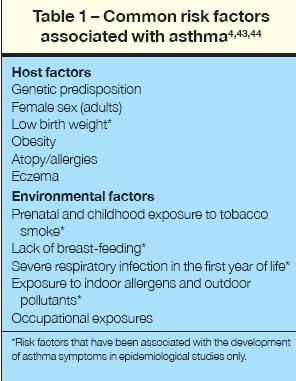
Obesity has been shown to be an independent risk factor, perhaps because of the influence of leptins on airway function; obesity also may play a role in asthma severity and control.5 A history of childhood wheezing, eczema, and allergies is frequently associated with a diagnosis of asthma in young adults, while the clinical presentation in older adults is less strongly associated with an allergic diathesis.
The classic clinical presentation of asthma includes waxing and waning symptoms of dyspnea, cough, wheezing, and chest tightness. An exacerbation of symptoms is usually gradual in onset and cessation and is frequently associated with triggers, such as exposure to common allergens, cold weather, and viral infections. Physical exercise can also cause asthma symptoms and may be the only trigger in some patients. Nocturnal symptoms are common in patients with poorly controlled asthma, and increased numbers of airway inflammatory cells have been demonstrated in the early morning hours.6
Physical examination findings are frequently normal in persons with asthma, but the examination may reveal stigmata of allergic rhinitis, eczema, or airflow obstruction. Although the presence of wheezing may suggest a diagnosis of asthma, its predictive value is quite poor.7 Chest radiography and pulse oximetry are recommended, although the results are frequently normal. Blood work may demonstrate peripheral eosinophilia or an elevated IgE level, but it is often not necessary or cost-effective in the initial diagnostic evaluation.
THE STANDARD TESTS
A variety of methods have been developed to objectively measure lung function to aid in the diagnosis of asthma (Table 2). Understanding the strengths and limitations of these tests can be vital to correctly interpret results and guide subsequent clinical decisions in patients with suspected or confirmed asthma.
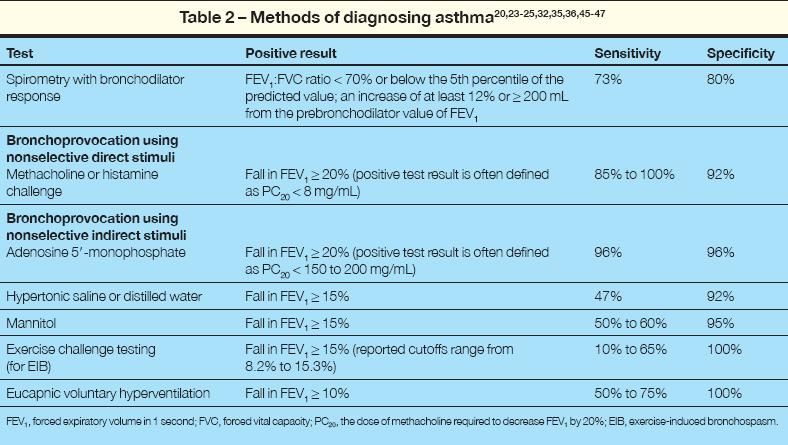
Spirometry
The recently updated National Asthma Education and Prevention Program (NAEPP) guidelines place an increased emphasis on pulmonary function testing, using spirometry both for initial diagnosis and for long-term follow-up of asthma.8 Objective measurement of lung function is important to confirm the diagnostic impression, to provide additional information regarding disease severity and associated risk, and to exclude other diagnoses.
Clinical signs and symptoms should be assessed at every health care visit. In addition, a variety of disease-specific quality of life measurements, such as the Asthma Quality of Life Questionnaire, have been developed to quantify the effect of asthma on a patient's health and well-being. Although these assessment tools can provide significant insight into the functional status of patients and populations, their use in isolation is limited by their overall poor correlation with objective measures of physiological impairment.9,10
Spirometry is an important objective component of the longterm assessment of asthma control because some patients underestimate or fail to accurately perceive the severity of their airflow obstruction. Recommendations include performing spirometry at the time of initial assessment, after treatment is initiated and symptoms have stabilized, during a period of progressive or prolonged loss of asthma control, and at least every 1 to 2 years after to assess the maintenance of lung function.8
Spirometry is the preferred modality because it is a simple, relatively low-cost screening test that can rapidly identify and assess the severity of airway obstruction. Although peak expiratory flow (PEF) measurement can be an effective screening tool for patients with asthma symptoms, it should not be used as the primary method of pulmonary function testing because it is more variable (and less reliable) than spirometry. However, PEF measurements are useful for daily outpatient monitoring of airflow limitation, identifying exacerbations, and assessing the effects of changes in treatment.4,8
Guidelines for proper spirometry performance and interpretation were revised in 2005.11 Airflow obstruction is present when the ratio of forced expiratory volume in 1 second (FEV1)o forced vital capacity (FVC) is less than 70%. For adults who require a prolonged period of maximal effort to complete exhalation because of severe obstructive lung disease, substitution of the FEV in 6 seconds is an option; this method has been shown to accurately classify physiological abnormalities and is less physically demanding than measuring FVC.12
The NAEPP recommends that all spirometric measurements in patients with diagnosed or suspected asthma should be performed before and after bronchodilator administration. Clinically significant reversible airway obstruction is defined as an increase of at least 12% and 200 mL in either FVC or FEV1 after administration of a short-acting bronchodilator (such as albuterol, 2 to 4 puffs at 90 μg/puff). This reversible airway obstruction correlates with evidence of airway inflammation measured by sputum eosinophilia and increased levels of exhaled nitric oxide, and it may help identify patients who are at greater risk for progressive loss of lung function.13,14
Methacholine challenge
Bronchoprovocation challenge (BPC) testing is generally considered the next diagnostic step when spirometric findings are normal in a patient in whom asthma is suspected. Methacholine (acetyl--methylcholine chloride) is the cholinergic agent most commonly used in clinical settings because of its well-established safety profile.15
BPC protocols involve the inhalation of up to 5 or 10 sequentially increasing concentrations of methacholine and the measurement of FEV1 and subjective symptoms after each dose (Table 3). Testing stops if a maximum methacholine concentration of 16 mg/mL is reached without a significant change in lung function; a fall in FEV1 of more than 20% from baseline at any time during the test constitutes a positive result. Lower PC20 values (the dose of methacholine that is required to decrease FEV1 by 20%) are associated with greater evidence of airway hyperresponsiveness.
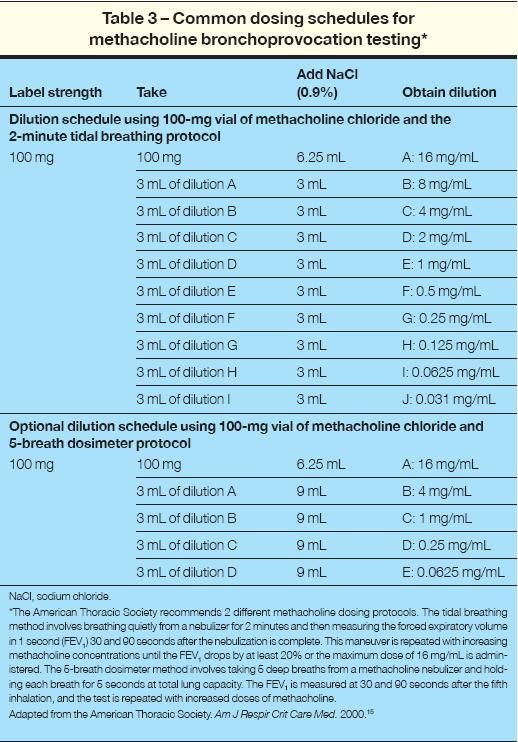
The advantage of BPC with methacholine lies in its negative predictive value (more than 90% with a PC20 greater than 8 to 16 mg/mL and a pretest probability of 30% to 70%) and its positive predictive value in a population with a high prevalence of asthma (the post-test certainty is 90% to 98% when pretest probability is 20% to 80% and the PC20 is less than 1 mg/mL). However, the clinical interpretation of borderline airway hyperreactivity (a PC20 of 4 to 16 mg/mL) must be approached with caution because of the high frequency of false-positive results that occur in this range.15
BPC with methacholine is time-intensive and requires significant patient effort. Some pulmonary function laboratories truncate testing at a maximum methacholine dose of 8 mg/mL because of the low post-test predictive value of borderline airway hyperreactivity associated with higher doses. Some experts recommend increasing the starting methacholine concentration in patients who have normal baseline spirometric measurements and no response to inhaled saline and in patients who have recently used inhaled corticosteroids or bronchodilators (Table 4).
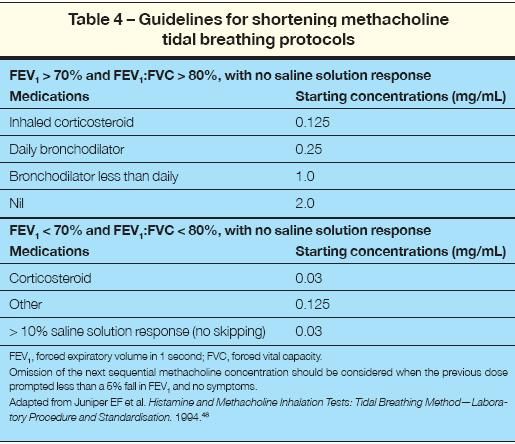
Other authorities recommend omission of the next sequential methacholine concentration in the dosing schedule if the previous dose resulted in less than a 5% fall in FEV1 and in no symptoms. Retrospective data support the safety of these practices.16,17
Alternative methods of BPC
Although BPC with methacholine remains the most common method of identifying bronchial hyperresponsiveness, the technique has drawbacks. Occasionally, lung function dramatically decreases after exposure to methacholine, and testing is not recommended for patients who exhibit baseline evidence of moderate airway obstruction (FEV1 less than 1.5 L or 60% of predicted).
Reasons for a false-positive result include a recent respiratory illness, exposure to cigarette smoke, and use of antihistamines or oral contraceptives. False-negative results are less common but may occur in patients who are taking high doses of anti-inflammatory medication at the time of testing and in those whose symptoms are triggered only by seasonal or occupational exposures.15
Numerous alternative methods of BPC testing have been developed on the basis of our current understanding of the pathophysiology of asthma. Histological evidence of airway inflammation, such as increased numbers of eosinophils, neutrophils, lymphocytes, and plasma cells in bronchial tissue, is common in patients who have asthma. Activated CD4+ T lymphocytes further promote inflammation by directing the release of inflammatory mediators, such as interleukin (IL)-4, IL-5, and IL-13, from eosinophils, mast cells, and other lymphocytes. These mediators cause mast cell degranulation, releasing histamine, leukotrienes, and other mediators that perpetuate airway inflammation.18 The physical manifestations of these changes include an exaggerated response to inhaled bronchoactive agents or to physical stimuli, along with airway wall thickening resulting from increased epithelium, submucosal hypertrophy, and increased bronchial smooth muscle.1,6,18,19
Both direct and indirect stimuli can promote airway hyperresponsiveness in asthma. Methacholine, for example, stimulates bronchoconstriction by binding directly to specific receptors on bronchial smooth muscle tissue. Indirect-acting stimuli cause inflammatory cells to release endogenous preformed mediators, which subsequently provoke bronchial smooth muscle contraction. These methods may better reflect acute changes in airway inflammation or the degree of inflammation, and changes in responsiveness to indirect stimuli may be a more relevant way of assessing changes in clinical course or response to asthma treatment.
Adenosine 5'-monophosphate (AMP) is an indirect agent that has generated significant interest in recent years. AMP stimulates the release of histamine from mast cells, resulting in bronchoconstriction. Corticosteroids and allergen avoidance tend to improve PC20 with AMP more than with methacholine, suggesting that BPC using AMP may correlate better with endogenous changes in airway inflammation. Moreover, the inverse correlation between sputum eosinophilia and PC20 with AMP is stronger than it is with methacholine.20
Other indirect-acting agents include hypertonic saline, distilled water, and mannitol. These agents have minimal effects on healthy persons but can cause profound bronchoconstriction in those with asthma. Hypersensitivity to changes in airway osmolarity is the likely mechanism that stimulates endogenous mediator release and airway smooth muscle contraction.21 BPC using these agents is generally more specific but less sensitive than testing with direct-acting agents, according to published testing protocols and thresholds for positive test result interpretation.22-25 Safety with these agents is good, although at least 1 case of fatal asthma has been reported during BPC with nebulized distilled water.26
Physical stimuli such as exercise have been used to help establish the diagnosis of asthma. The high minute ventilation that occurs with exercise causes airway temperature and moisture to fall, and the bronchial mucosa rapidly transfers heat and water to humidify and warm inspired air to body temperature. These rapid fluxes in airway heat and moisture are thought to cause bronchial narrowing. While this mechanism is not completely understood, one hypothesis suggests that evaporation of mucosal surface water and increases in osmolarity cause mast cell degranulation and constriction of airway smooth muscle.
Another theory relates to the observation that patients with asthma have a hyperplastic capillary bed. Hyperemia of the airway microcirculation may result in bronchial mucosal edema, further contributing to airway narrowing. While inflammatory mediators clearly play a role in the pathogenesis of asthma, their role in exercise-induced bronchoconstriction remains more controversial.27
Common exercise challenge protocols involve obtaining baseline spirometric measurements, followed by the patient exercising for 6 to 8 minutes on a treadmill or bicycle ergometer, then obtaining serial FEV1 measurements after exercise. While the threshold for a positive response is controversial, a decrease in FEV1 of 10% to 15% is considered to be suggestive of exercise-induced bronchospasm.15 Using this cutoff, the specificity of exercise provocation is close to 100%. Postexercise FEV1 decreases of 8.2% and 6.5% have been reported in healthy children and elite athletes, respectively. Using these values as a cutoff, the sensitivity of this test is at most 65%.28-32
Eucapnic voluntary hyperventilation has been studied as an alternative method of diagnosing airway hyperreactivity and exerciseinduced bronchospasm. Both exercise and hyperventilation with a steady level of carbon dioxide produce similar intrathoracic thermal profiles as described above.33 The test requires the patient to voluntarily hyperventilate a dry gas consisting of air and 5% carbon dioxide at room temperature. The concentration of carbon dioxide in this mixture allows carbon dioxide levels to remain within a specified range and avoids bronchoconstriction resulting from hypocapnia. FEV1 is recorded before hyperventilation; immediately after it; and then at 5, 10, and 20 minutes following the challenge.34
When using a fall in FEV1 of more than 11% during eucapnic voluntary hyperventilation, the reported specificity is 100% but the sensitivity is only 50% for exerciseinduced bronchospasm.35 However, the sensitivity of eucapnic voluntary hyperventilation in diagnosing asthma using a drop in FEV1 of more than 10% has been reported to be as high as 75%.36
NEW TECHNIQUES
Although spirometry remains the recommended method of measuring lung function in patients with asthma, it is generally considered to be a relatively insensitive measure of small-airway changes and ongoing airway inflammation. Current clinical research goals of the National Heart, Lung, and Blood Institute include identifying new techniques to detect obstructive lung disease early in its clinical course and to more effectively monitor patients who are at higher risk for disease progression.8 The forced oscillation technique and measurement of exhaled nitric oxide are 2 novel testing methods that show promise.
Forced oscillation technique
The forced oscillation technique, which is also known as impulse oscillometry, was first introduced in 1956 and has gained wide acceptance in Europe as a nonvolitional method of evaluating lung function in children.37 The device generates harmonic sound waves of various frequencies that are passively transmitted through the airways while the patient maintains normal tidal breathing.
The reflected pressure and flow signals of these oscillations are measured at the mouth, and the changes in phase and amplitude are used to calculate a variety of different measurements. Small-airway changes from obstructive lung disease are identified by increased resistance measurements at low frequencies (R at 5 Hz, or R5), a change in resistance from high to low frequencies of at least 20% (frequency dependence of resistance from 5 Hz to 20 Hz, or R5 to R20), and an increased reactance area.38
Interest in the forced oscillation technique in adults is increasing, fueled by a number of small studies that demonstrated that this method has greater sensitivity than spirometry for the detection of small-airway changes after bronchodilator and bronchoprovocation challenges.39-41 The technique holds promise for early detection and monitoring of asthma once larger adult reference sets are established.
Exhaled nitric oxide
Nitric oxide is a highly reactive molecule produced by nitric oxide synthase present throughout the lung. There is indirect evidence that nitric oxide synthase expression is up-regulated in the airways of patients with asthma, and elevated exhaled nitric oxide levels have been associated with airway mucosal eosinophil activation and other markers of allergic inflammation. Measurement of exhaled nitric oxide consists of inhaling nitric oxide–free gas to total lung capacity and exhaling at a constant flow rate of 50 mL/s until a steady plateau is reached on several reproducible efforts.
There is increasing evidence that exhaled nitric oxide may be a sensitive and effective tool in diagnosing asthma, especially when combined with other measures of bronchial hyperreactivity, and in monitoring disease activity. For example, it has been shown that a person's exhaled nitric oxide level increases with asthma exacerbations and decreases after treatment with inhaled corticosteroids. However, the clinical application of exhaled nitric oxide is currently limited by cost, significant inter-individual measurement variability, and the lack of asthma outcomes data when this technique is used as a monitoring tool.42
CONCLUSION
Asthma is a common, complex clinical problem with significant associated morbidity and mortality. With disease prevalence increasing in many countries, it is important to accurately diagnose asthma and monitor patients effectively to ensure that treatment is sufficient. The first step involves obtaining a complete history and physical examination, chest radiograph, and spirometry with bronchodilator testing. BPC testing, most commonly using methacholine, is recommended if the results of these initial tests are normal.
A variety of alternative agents and BPC methods have been developed, most of which offer improved specificity but decreased sensitivity compared with methacholine. The forced oscillation technique and exhaled nitric oxide measurements show significant promise as tools that are more sensitive to measure small-airway changes and inflammation, although further research is required to refine these techniques and to validate their effect on asthma outcomes. Clinical highlights are presented in Table 5.
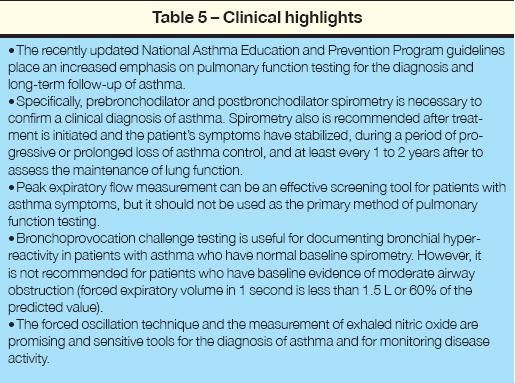
References:
REFERENCES
1.
Akinbami L; Centers for Disease Control and Prevention, National Center for Health Statistics. Asthma prevalence, health care use and mortality: United States, 2003-05. Available at:
http://www.cdc.gov/nchs/data/hestat/asthma03-05/asthma03-05.htm
. Accessed July 9,2007.
2.
Morris MJ, Grbach VX, Deal LE, et al. Evaluation of exertional dyspnea in the active duty patient: the diagnostic approach and the utility of clinical testing.
Mil Med.
2002;167:281-288.
3.
Enright PL, McClelland RL, Newman AB, et al. Underdiagnosis and undertreatment of asthma in the elderly.
Chest.
1999;116:603-613.
4.
Global Initiative for Asthma. GINA Report, Global Strategy for Asthma Management and Prevention. Available at:
http://www.ginasthma.org
. Revised 2006. Accessed July 9, 2007.
5.
Shore SA. Obesity and asthma: implications for treatment.
Curr Opin Pulm Med.
2007;13:56-62.
6.
Shigemitsu H, Afshar K. Nocturnal asthma.
Curr Opin Pulm Med.
2007;13:49-55.
7.
Pratter MR, Curley FJ, Dubois J, et al. Cause and evaluation of chronic dyspnea in a pulmonary disease clinic.
Arch Intern Med.
1989;149:2277- 2282.
8.
National Asthma Education and Prevention Program. Expert Panel Report 3: Guidelines for the Diagnosis and Management of Asthma-Summary Report 2007.
J Allergy Clin Immunol.
2007;120(5 suppl):S93-S138.
9.
Bijl-Hofland ID, Cloosterman SG, van Schayck CP, et al. Perception of respiratory sensation assessed by means of histamine challenge and threshold loading tests.
Chest.
2000;117:954-959.
10.
Kikuchi Y, Okabe S, Tamura G, et al. Chemosensitivity and perception of dyspnea in patients with a history of near-fatal asthma.
N Engl J Med.
 1994;330:1329-1334.
11.
Miller MR, Crapo R, Hankinson J, et al; ATS/ERS Task Force. General considerations for lung function testing.
Eur Respir J.
2005;26:153-161.
12.
Swanney MP, Beckert LE, Frampton CM, et al. Validity of the American Thoracic Society and other spirometric algorithms using FVC and forced expiratory volume at 6 s for predicting a reduced total lung capacity.
Chest.
2004;126:1861-1866.
13.
Covar RA, Spahn JD, Martin RJ, et al. Safety and application of induced sputum analysis in childhood asthma.
J Allergy Clin Immunol.
2004;114:575-582.
14.
Ulrik CS, Backer V. Nonreversible airflow obstruction in life-long nonsmokers with moderate to severe asthma.
Eur Respir J.
1999;14:892-896.
15.
American Thoracic Society. Guidelines for methacholine and exercise challenge testing-1999.
Am J Respir Crit Care Med.
2000;161:309-329.
16.
Cockcroft DW, Marciniuk DD, Hurst TS, et al. Methacholine challenge: test-shortening procedures.
Chest.
2001;120:1857-1860.
17.
Izbicki G, Bar-Yishay E. Methacholine inhalation challenge: a shorter, cheaper and safe approach.
Eur Respir J.
2001;17:46-51.
18.
Fireman P. Understanding asthma pathophysiology.
Allergy Asthma Proc.
2003;24:79-83.
19.
Awadh N, Müller NL, Park CS, et al. Airway wall thickness in patients with near fatal asthma and control groups: assessment with high resolution computed tomographic scanning.
Thorax.
1998;53:248-253.
20.
Cain H. Bronchoprovocation testing.
Clin Chest Med.
2001;22:651-659.
21.
Joos GF, O’Connor B, Anderson SD, et al. Indirect airway challenges.
Eur Respir J.
2003;21:1050-1068.
22.
de Meer G, Marks GB, de Jongste JC, Brunekreef B. Airway responsiveness to hypertonicsaline: dose-response slope or PD15?
Eur Respir J.
2005;25:153-158.
23.
Riedler J, Reade T, Dalton M, et al. Hypertonic saline challenge in an epidemiologic survey of asthma in children.
Am J Respir Crit Care Med.
1994;150:1632-1639.
24.
Koskela HO, Hyvärinen L, Brannan JD, et al. Responsiveness to three bronchial provocation tests in patients with asthma.
Chest.
2003;124:2171-2177.
25.
Brannan JD, Anderson SD, Perry CP, et al. The safety and efficacy of inhaled dry powder mannitol as a bronchial provocation test for airway hyperresponsiveness: a phase 3Â comparison study with hypertonic (4.5%) saline.
Respir Res.
2005;6:144.
26.
Saetta M, Di Stefano A, Turato G, et al. Fatal asthma attack during inhalation challenge with ultrasonically nebulized distilled water.
J Allergy Clin Immunol.
1995;95:1285-1287.
27.
McFadden ER Jr, Gilbert IA. Exercise-induced asthma.
N Engl J Med.
1994;330:1362-1367.
28.
Haby MM, Anderson SD, Peat JK, et al. An exercise challenge protocol for epidemiological studies of asthma in children: comparison with histamine challenge.
Eur Respir J.
1994;7:43-49.
29.
Godfrey S, Springer C, Noviski N, et al. Exercise but not methacholine differentiates asthma from chronic lung disease in children.
Thorax.
1991;46:488-492.
30.
Kattan M, Keens TG, Mellis CM, et al. The response to exercise in normal and asthmatic children.
J Pediatr.
1978;92:718-721.
31.
Helenius IJ, Tikkanen HO, Haahtela T. Exercise-induced bronchospasm at low temperature in elite runners.
Thorax.
1996;51:628-629.
32.
Avital A, Godfrey S, Springer C. Exercise, methacholine, and adenosine 59-monophosphate challenges in children with asthma: relation to severity of the disease.
Pediatr Pulmonol.
2000;30:207-214.
33.
Gilbert IA, Fouke JM, McFadden ER Jr. Intra-airway thermodynamics during exercise and hyperventilation in asthmatics.
J Appl Physiol.
1988;64:2167-2174.
34.
Anderson SD, Argyros GJ, Magnussen H, Holzer K. Provocation by eucapnic voluntary hyperpnoea to identify exercise induced bronchoconstriction.
Br J Sports Med.
2001;35:344-347.
35.
Eliasson AH, Phillips YY, Rajagopal KR, Howard RS. Sensitivity and specificity of bronchial provocation testing. An evaluation of four techniques in exercise-induced bronchospasm.
Chest.
1992;102:347-355.
36.
Roach JM, Hurwitz KM, Argyros GJ. Eucapnic voluntary hyperventilation as a bronchoprovocation technique. Comparison with methacholine inhalation in asthmatics.
Chest.
1994;105:667-672.
37.
Dubois AB, Brody AW, Lewis DH, Burgess BF Jr. Oscillation mechanics of lungs and chest in man.
J Appl Physiol.
1956;8:587-594.
38.
Goldman MD. Clinical application of forced oscillation.
Pulm Pharmacol Ther.
2001;14:341-350.
39.
Wouters EF, Polko AH, Visser BF. Response localization of the pharmacological agents histamine and salbutamol along the respiratory system by forced oscillations in asthmatic subjects.
J Asthma.
1989;26:185-193.
40.
Zerah F, Lorino AM, Lorino H, et al. Forced oscillation technique vs spirometry to assess bronchodilatation in patients with asthma and COPD.
Chest.
1995;108:41-47.
41.
Van Noord JA, Smeets J, Clement J, et al. Assessment of reversibility of airflow bstruction.
Am J Respir Crit Care Med.
1994;150:551-554.
42.
Bates CA, Silkoff PE. Exhaled nitric oxide in asthma: from bench to bedside.
J Allergy Clin Immunol.
2003;111:256-262.
43.
King ME, Mannino DM, Holguin F. Risk factors for asthma incidence. A review of recent prospective evidence.
Panminerva Med.
2004;46:97-110.
44.
Arruda LK, Solé D, Baena-Cagnani CE, Naspitz CK. Risk factors for asthma and atopy.
Curr Opin Allergy Clin Immunol.
2005;5:153-159.
45.
Chhabra SK. Acute bronchodilator response has limited value in differentiating bronchial asthma from COPD.
J Asthma.
2005;42:367-372.
46.
Goldstein MF, Veza BA, Dunsky EH, et al. Comparisons of peak diurnal expiratory flow variation, postbronchodilator FEV
1
responses, and methacholine inhalation challenges in the evaluation of suspected asthma.
Chest.
2001;119:1001-1010.
47.
Berkman N, Avital A, Breuer R, et al. Exhaled nitric oxide in the diagnosis of asthma: comparison with bronchial provocation tests.
Thorax.
2005;60:383-388.
48.
Juniper EF, Cockcroft DW, Hargreave FE.
Histamine and Methacholine Inhalation Tests: Tidal Breathing Method-Laboratory Procedure and Standardisation.
2nd ed. Lund, Sweden: AB Draco; 1994.
PRACTICE GUIDELINES
• American Thoracic Society. Guidelines for methacholine and exercise challenge testing-1999.
Am J Respir Crit Care Med.
2000;161:309-329.
• Global Initiative for Asthma. GINA Report, Global Strategy for Asthma Management and Prevention. Available at:
http://www.ginasthma.org
. Revised 2006. Accessed July 9, 2007.
• National Asthma Education and Prevention Program. Expert Panel Report 3: Guidelines for the Diagnosis and Management of Asthma-Summary Report 2007.
J Allergy Clin Immunol.
2007;120(5 suppl):S93-S138.
